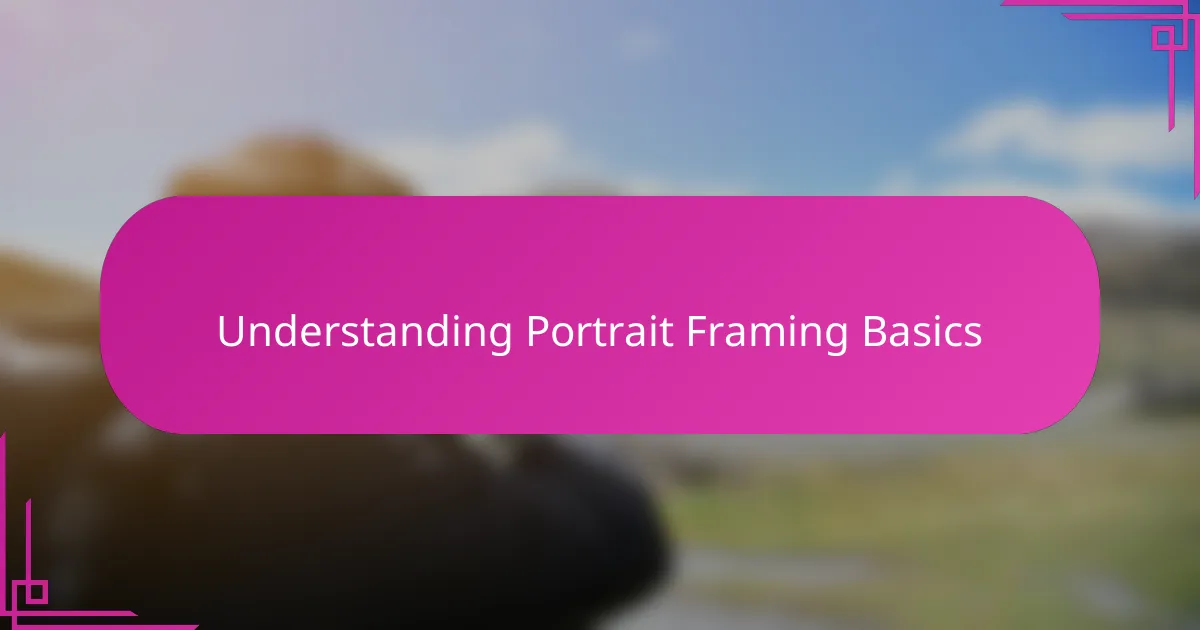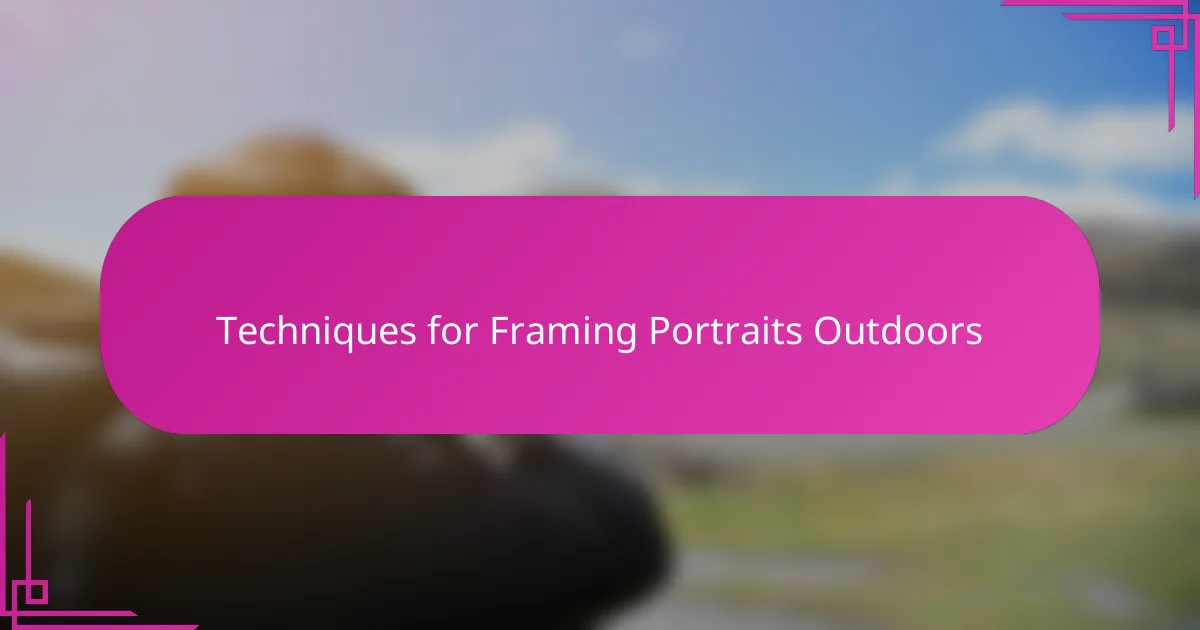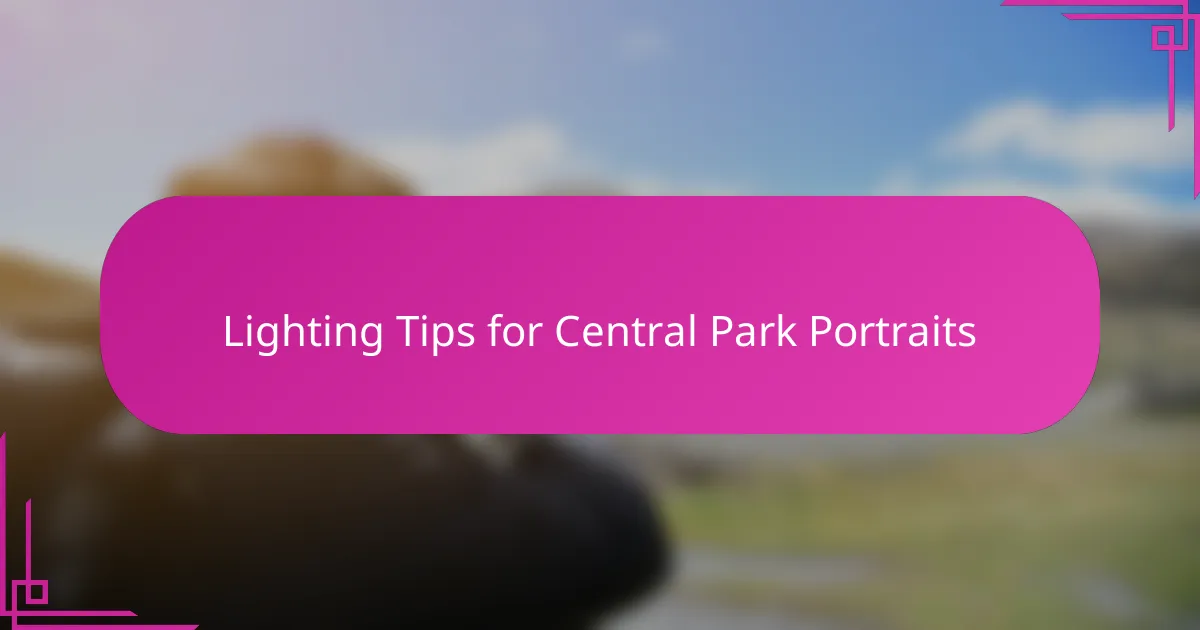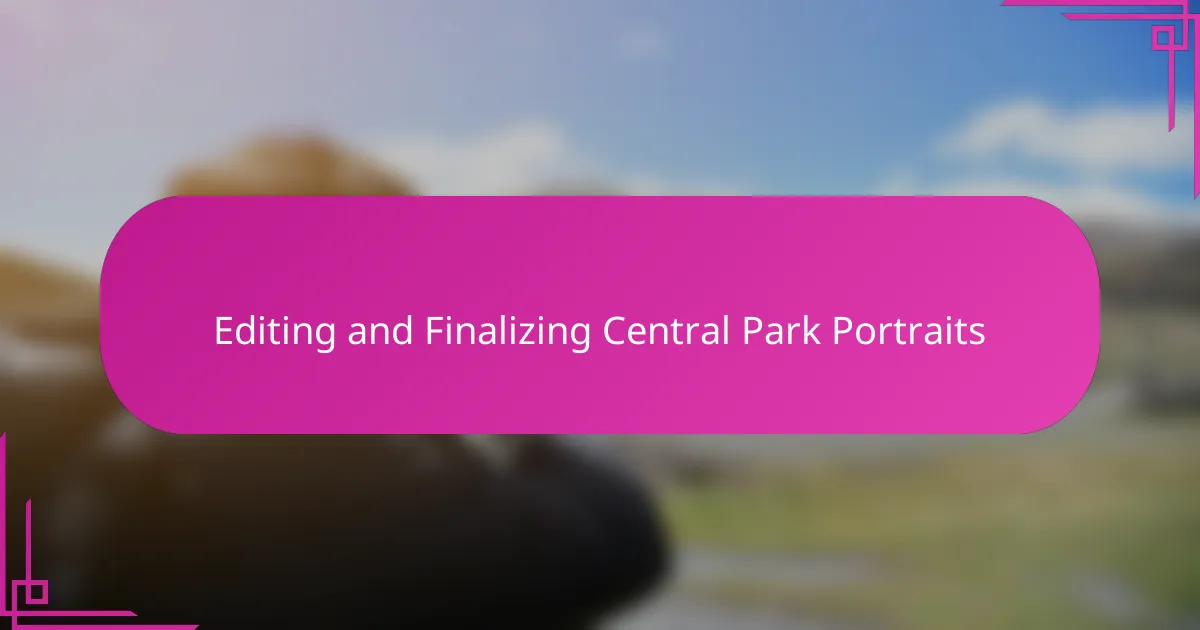Key takeaways
- Framing portraits effectively involves emotional intuition and compositional choices that enhance the subject’s expression and story.
- Using quality equipment, especially prime lenses and efficient lighting techniques, is crucial for capturing compelling images in settings like Central Park.
- Natural elements and changing seasons provide dynamic backdrops that can dramatically alter the mood and depth of portraits.
- Editing should focus on enhancing natural light and colors while maintaining the connection between the subject and their environment for a more impactful final image.

Understanding Portrait Framing Basics
When I frame a portrait, I always start by thinking about how the subject fits within the frame. It’s not just about centering a face; it’s about capturing the mood and telling a story through space and composition. Have you noticed how a slight shift to one side can completely change the feeling of an image?
One thing I’ve learned is that framing isn’t just a technical task—it’s an emotional decision. For example, including too much background can distract from the expression, but sometimes that background adds depth and context that can’t be replicated. Balancing these choices is what separates a snapshot from a compelling portrait.
I often ask myself: What do I want the viewer to feel when looking at this portrait? The answer guides how tight or loose I frame the shot. It’s this subtle intuition, developed through experience, that transforms a simple portrait into something memorable.

Choosing the Right Equipment for Portraits
Choosing the right equipment for portraits is like picking the perfect brush for a painting. I usually reach for a prime lens, typically a 50mm or 85mm, because they help me isolate my subject beautifully against Central Park’s ever-changing backdrop. Do you know that feeling when your lens almost feels like an extension of your eye? That’s when the equipment truly gets out of the way and lets your vision come through.
From my experience, having a camera body with good low-light performance is essential. Central Park’s natural light can be soft and tricky, especially during golden hour, and I want to capture every subtle expression without cranking up the ISO too much. I remember a session where my camera’s sensor made all the difference in freezing a fleeting smile amidst the shaded trees.
And then there’s the tripod. I don’t always use one for portraits, but when I do, it’s because I want to slow down and compose every element deliberately. Ever tried framing a portrait with your subjects moving around? A sturdy tripod keeps the camera steady while I focus on creating a connection with the person in front of me rather than wrestling with shaky hands.

Exploring Central Park as a Photography Location
Central Park offers such an incredible variety of backdrops that every corner feels like a new story waiting to be told through my lens. I’ve found that wandering off the beaten paths often reveals the most unexpected spots—the way light filters through the trees near the Ramble always seems to create portraits with a magical, almost painterly quality. Have you ever noticed how the park’s mix of urban and natural elements provides endless creative contrasts?
One of my favorite things about shooting in Central Park is how the season dramatically alters the mood and framing options. In spring, the blossoms add a delicate touch, while autumn’s fiery foliage brings warmth and depth that can make a portrait truly sing. It’s fascinating how the same location can feel completely different simply through the changing light and colors.
But it’s not just about scenery; the people in the park contribute an energy that’s hard to replicate elsewhere. I recall a portrait session by the Bethesda Terrace where the casual passersby and street performers added an authentic buzz, making the scenes feel alive and spontaneous. Don’t you think capturing that living atmosphere breathes real life into a portrait?

Techniques for Framing Portraits Outdoors
Framing portraits outdoors often means working with natural elements like trees, benches, or pathways to create a natural frame around your subject. I remember once using a cluster of branches to subtly encircle a model’s face, which added a tender, intimate feel to the shot. Have you tried letting nature act as your framing tool rather than relying solely on your camera’s crop?
Light plays a crucial role in framing outside, too. I find that positioning my subject near patches of soft, dappled sunlight filters the portrait beautifully, creating natural highlights that guide the viewer’s eye. It’s almost like the light itself becomes part of the frame, enveloping the person gently and shaping the mood.
Sometimes, I experiment with negative space to enhance the framing. Leaving ample empty space beside the subject can evoke a sense of openness or contemplation, especially in a vast outdoor environment like Central Park. Have you noticed how that breathing room can actually pull focus toward the emotions on your subject’s face? It’s a powerful technique I rely on to give portraits more emotional impact.

Lighting Tips for Central Park Portraits
Lighting in Central Park can be wonderfully unpredictable, which keeps me on my toes during every shoot. I like to arrive early and observe how the sun moves through the trees, looking for those gentle shafts of light that create soft, natural highlights on my subject’s face. Have you ever waited patiently for that perfect moment when the light feels just right, like a spotlight gently embracing your subject?
I’ve learned to avoid harsh midday sun when shooting portraits in Central Park because it tends to cast unflattering shadows and highlights. Instead, I aim for the golden hours—shortly after sunrise or before sunset—when the light is warm and diffused, lending a flattering glow that really accentuates skin tones and expressions. It’s during these times that the park seems to transform, making every portrait feel more intimate and genuine.
When natural light isn’t cooperating, I sometimes use a reflector to bounce light back onto my subject’s face, especially in shaded areas beneath the dense canopy. This simple tool helps me control contrast without overpowering the natural ambiance. Have you tried working with reflectors in unpredictable outdoor settings? From my experience, it’s a small accessory that makes a big difference in shaping light and mood.

Personal Workflow for Framing Portraits
My personal workflow for framing portraits starts with a mental sketch of the final image—where I want the subject to sit within the frame and what story that placement will tell. I tend to adjust the crop dynamically as I shoot, sometimes stepping closer or pulling back, depending on how my subject’s expression shifts. Have you ever noticed how changing the framing even slightly can breathe new life into the same pose?
I also make a habit of scanning the edges of my frame before the shutter clicks to ensure there’s nothing distracting breaking the visual flow. One time during a session near the Bow Bridge, I caught a stray branch creeping in that, once removed through a small camera adjustment, transformed the portrait’s mood from cluttered to serene. It’s these little moments that remind me framing is both art and mindfulness.
Finally, I listen closely to my subject’s energy to decide how tight or open the frame should be. If they feel relaxed and playful, I give them room to move within the frame, letting the environment complement their vibe. On the flip side, when emotions run deep, I tighten the crop to pull the viewer’s attention solely onto their eyes or hands—those subtle details that reveal so much. Don’t you find that tailoring the framing to the subject’s mood makes portraits infinitely more compelling?

Editing and Finalizing Central Park Portraits
Editing Central Park portraits for me is where the magic truly emerges. I often start by adjusting the exposure and contrast just enough to let the natural light I captured shine through—Central Park’s soft shadows and highlights don’t need heavy-handed alterations. Have you ever noticed how a subtle tweak in brightness can completely change the mood, turning a casual snapshot into a moment that feels timeless?
Color grading plays a huge role, too. I like to enhance the warm autumn hues or the fresh spring greens without making them look unnatural. One time, I spent extra time on a portrait taken near the Cherry Hill, carefully balancing the pink blossoms and skin tones until the image felt alive—like you could almost smell the flowers. It’s those details that make a difference between a good photo and one that tells a story.
Final touches often involve cropping and straightening to fine-tune the frame, but I resist the urge to over-crop. I remind myself that part of Central Park’s charm is its vibrant, organic surroundings. Would a tighter crop erase the feeling of space and freedom? For me, preserving that connection between subject and setting is what finalizing a portrait in this iconic park is all about.